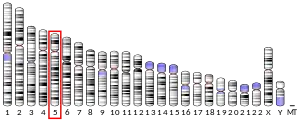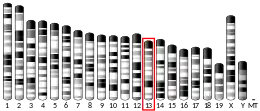Kelch-like protein 3
Kelch-like protein 3 is a protein in humans that is encoded by the KLHL3 gene.[5] Alternative splicing results in multiple transcript variants encoding distinct isoforms.
| KLHL3 | |||||||||||||||||||||||||||||||||||||||||||||||||||
|---|---|---|---|---|---|---|---|---|---|---|---|---|---|---|---|---|---|---|---|---|---|---|---|---|---|---|---|---|---|---|---|---|---|---|---|---|---|---|---|---|---|---|---|---|---|---|---|---|---|---|---|
| |||||||||||||||||||||||||||||||||||||||||||||||||||
| Identifiers | |||||||||||||||||||||||||||||||||||||||||||||||||||
| Aliases | KLHL3, PHA2D, kelch like family member 3 | ||||||||||||||||||||||||||||||||||||||||||||||||||
| External IDs | OMIM: 605775 MGI: 2445185 HomoloGene: 79542 GeneCards: KLHL3 | ||||||||||||||||||||||||||||||||||||||||||||||||||
| |||||||||||||||||||||||||||||||||||||||||||||||||||
| |||||||||||||||||||||||||||||||||||||||||||||||||||
| |||||||||||||||||||||||||||||||||||||||||||||||||||
| |||||||||||||||||||||||||||||||||||||||||||||||||||
| |||||||||||||||||||||||||||||||||||||||||||||||||||
| Wikidata | |||||||||||||||||||||||||||||||||||||||||||||||||||
| |||||||||||||||||||||||||||||||||||||||||||||||||||
Function
This gene is ubiquitously expressed and encodes a full-length protein which has an N-terminal BTB domain followed by a BACK domain and six kelch-like repeats in the C-terminus. These kelch-like repeats promote substrate ubiquitination of bound proteins via interaction of the BTB domain with the CUL3 (cullin 3) component of a cullin-RING E3 ubiquitin ligase (CRL) complex.[5]
Clinical significance
Mutations in this gene cause pseudohypoaldosteronism type IID (PHA2D); a rare Mendelian syndrome featuring hypertension, hyperkalaemia[6] and metabolic acidosis.[5]
References
- GRCh38: Ensembl release 89: ENSG00000146021 - Ensembl, May 2017
- GRCm38: Ensembl release 89: ENSMUSG00000014164 - Ensembl, May 2017
- "Human PubMed Reference:". National Center for Biotechnology Information, U.S. National Library of Medicine.
- "Mouse PubMed Reference:". National Center for Biotechnology Information, U.S. National Library of Medicine.
- "Entrez Gene: Kelch-like 3 (Drosophila)". Retrieved 2012-04-26.
- "KLHL3 mutations cause familial hyperkalemic hypertension by impairing ion transport in the distal nephron". Nature Genetics. 44 (5): 609. Apr 26, 2012. doi:10.1038/ng0512-609.
Further reading
- Hirosawa M, Nagase T, Ishikawa K, Kikuno R, Nomura N, Ohara O (Oct 1999). "Characterization of cDNA clones selected by the GeneMark analysis from size-fractionated cDNA libraries from human brain". DNA Research. 6 (5): 329–36. doi:10.1093/dnares/6.5.329. PMID 10574461.
- Yeo A, Samways DS, Fowler CE, Gunn-Moore F, Henderson G (Mar 2001). "Coincident signalling between the Gi/Go-coupled delta-opioid receptor and the Gq-coupled m3 muscarinic receptor at the level of intracellular free calcium in SH-SY5Y cells". Journal of Neurochemistry. 76 (6): 1688–700. doi:10.1046/j.1471-4159.2001.00185.x. PMID 11259487. S2CID 2755275.
- Mizutani A, Fukuda M, Ibata K, Shiraishi Y, Mikoshiba K (Mar 2000). "SYNCRIP, a cytoplasmic counterpart of heterogeneous nuclear ribonucleoprotein R, interacts with ubiquitous synaptotagmin isoforms". The Journal of Biological Chemistry. 275 (13): 9823–31. doi:10.1074/jbc.275.13.9823. PMID 10734137.
- Lai F, Orelli BJ, Till BG, Godley LA, Fernald AA, Pamintuan L, Le Beau MM (May 2000). "Molecular characterization of KLHL3, a human homologue of the Drosophila kelch gene". Genomics. 66 (1): 65–75. doi:10.1006/geno.2000.6181. PMID 10843806.
This article is issued from Wikipedia. The text is licensed under Creative Commons - Attribution - Sharealike. Additional terms may apply for the media files.



